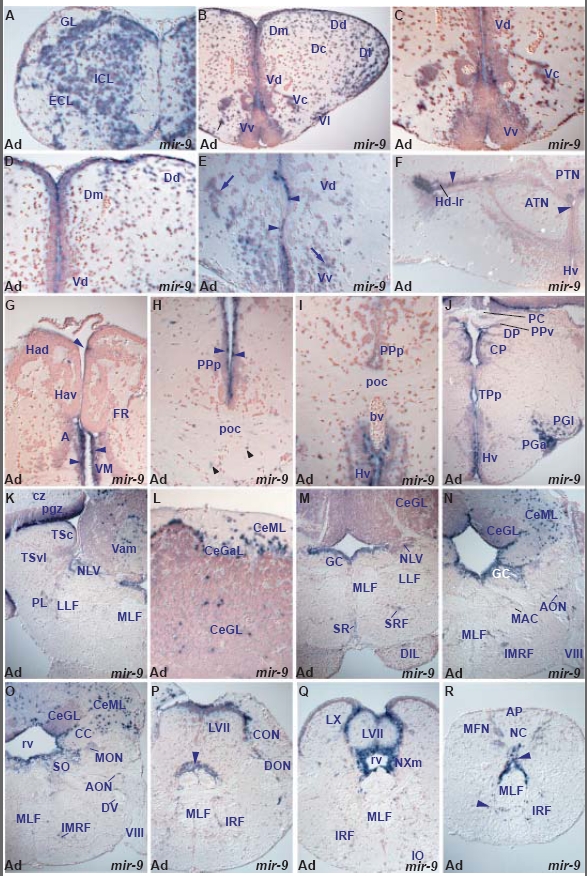Fig. S4
miR-9 expression in the adult zebrafish brain.
miR-9 is expressed in both periventricular and adjacent cells of proliferative zones and differentiating cells arising from these domains. miR-9 expressing cells are widespread in all brain subdivisions (fore-, mid- and hind-brain) although some areas such as the larval epithalamus and the hypothalamic lateral torus are devoid of expression (Table A). In addition to the brain, miR-9 is expressed in the inner retinal nuclear layer and ciliary marginal zone. miR-9 expression is highly conserved between larval and adult brain and we find only minor differences at the regional level (Table A,F). miR-9 is expressed in a few adult habenular and hypothalamic lateral torus cells, areas devoid of larval expression.
A. transverse section through the adult olfactory bulb showing miR-9 expressing cells in the internal (ICL), external (ECL) cellular and glomerular (GL) olfactory layers.
B. transverse section through the adult telencephalon showing miR-9 expressing cells in the ventral (Vv), lateral (Vl), central (Vc) and dorsal (Vd) nuclei of the ventral telencephalon (subpallium), medial (Dm), dorsal (Dd), central (Dc) and lateral (Dl) zones of the dorsal telencephalon (pallium).
C. higher magnification of B at the level of the subpallium showing miR-9 expressing cells in the ventral (Vv), central (Vc) and dorsal (Vd) nuclei of the ventral telencephalon.
D. higher magnification of B at the level of the pallium and dorsal subpallium showing miR-9 expressing cells in the dorsal nucleus of the ventral telencephalon (Vd), medial (Dm) and dorsal (Dd) zones of the dorsal telencephalon. Expression is present in many cells lining the ventricles in addition to presumptive neurons.
E. transverse section through the adult ventral telencephalon (caudal to sections B, C) showing periventricular (arrowheads) and lateral to the ventricle (arrows) miR-9 expressing cells in the ventral (Vv) and dorsal (Vd) nuclei of the ventral telencephalon.
F. transverse section through the adult hypothalamus showing miR-9 expressing cells in the dorsal zone of the periventricular hypothalamus (Hd). Arrowheads point at periventricular hypothalamic miR-9 expressing cells at the level of the lateral ventricular recess (lr) and more medially.
G. transverse section through the adult dorsal diencephalon showing a few miR-9 expressing cells in the dorsal habenular nucleus (Had), anterior (A) and ventromedial (VM) thalamic nuclei. Arrowheads point at periventricular miR-9 expressing cells.
H. transverse section through the adult caudal preoptic area at the level of the postoptic commissure (poc) showing miR-9 expressing cells in the posterior preoptic parvocellular nucleus (PPp). Blue arrowheads point at periventricular cells and black arrowheads point at miR-9 expressing cells at the level of the poc.
I. transverse section through the adult caudal preoptic area at the level of the postoptic commissure (poc) showing miR-9 expressing cells in the posterior parvocellular preoptic nucleus (PPp) and ventral zone of the periventricular hypothalamus (Hv).
J. transverse section through the adult diencephalon at the level of the posterior commissure (PC) showing miR-9 expressing cells in the ventral nucleus of the periventricular pretectum (PPv), dorsal (DP) and central (CP) posterior thalamic nuclei, periventricular nucleus of posterior tuberculum (TPp), ventral zone of the periventricular hypothalamus (Hv), anterior (PGa) and lateral (PGl) preglomerular nuclei.
K. transverse section through the adult caudal midbrain and rostral hindbrain showing miR-9 expressing cells in the perilemniscal nucleus (PL), nucleus of the lateral valvula (NLV), medial division of cerebellar valvula (Vam) and periventricular gray (pgz) and central (cz) zones of the optic tectum.
L. transverse section through the adult cerebellum showing miR-9 expressing cells in the granular (CeGL), ganglionic (CeGaL) and molecular (CeML) cerebellar layers.
M. transverse section through the adult rostral hindbrain showing miR-9 expressing cells in the superior reticular formation (SRF), superior raphe (SR), central gray (GC), nucleus of the lateral valvula (NLV) and granular cerebellar layer (CeGL).
N. transverse section through the adult hindbrain at the level of the octaval nerve (VIII) showing miR-9 expressing cells in the intermediate reticular formation (IMRF), anterior octaval nucleus (AON), central gray (GC), granular (CeGL) and molecular (CeML) cerebellar layers.
O. transverse section through the adult rostral hindbrain at the level of the octaval nerve (VIII, caudal to section N) showing miR-9 expressing cells in the intermediate reticular formation (IMRF), anterior (AON), secondary octaval (SO) and medial octavolateral (MON) nuclei, cerebellar crest (CC), granular (CeGL) and molecular (CeML) cerebellar layers.
P. transverse section through the adult hindbrain at the level of octaval nerve (VIII, caudal to section N) showing miR-9 expressing cells in the inferior reticular formation (IRF), descending octaval (DON) and caudal octavolateral (CON) nuclei and facial lobe (LVII). The arrowhead points at periventricular cells around the rhombencephalic ventricle expressing miR-9.
Q. transverse section through the adult caudal hindbrain at the level of the vagal motor nucleus (NXm) showing miR-9 expressing cells surrounding the rhombencephalic ventricle (rv), in the facial (LVII) and vagal (LX) lobes and inferior reticular formation (IRF).
R. transverse section through the adult caudal hindbrain at the level of the area postrema (AP) showing miR-9 expressing cells in the lateral part of the commissural nucleus of Cajal (NC) and surrounding (arrowheads) the rhombencephalic ventricle and medial longitudinal fascicle (MLF).

